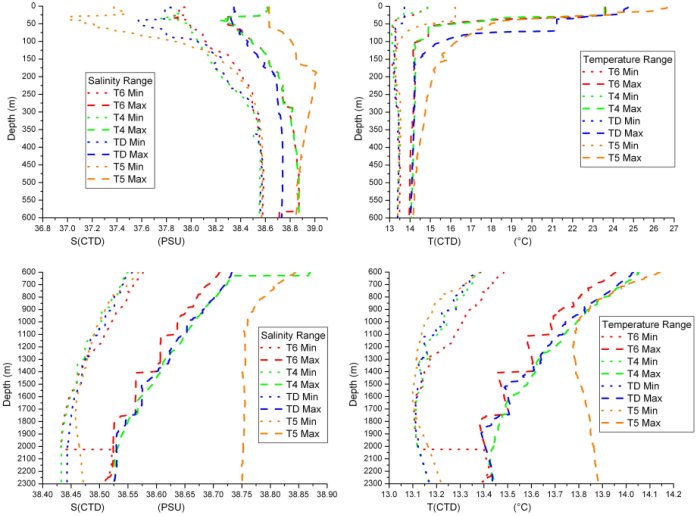Factors affecting quality of XBT data: results of analyses on profiles from the western Mediterranean Sea
Franco Reseghetti
ENEA Centro Ricerche Ambiente Marino S. Teresa, Lerici, Italy
ABSTRACT
The Mediterranean waters are characterized by relatively vertical homogeneity with respects to other parts of the world ocean. In particular: 1) vertically homogeneous profiles are usually found in particular areas of dense water formation; 2) in many areas, sea surface layer temperatures during winter are usually colder than at deeper depth. This unstable temperature gradient is compensated at depth by the salt.
In practice, the Mediterranean Sea offers the possibility to analyze the motion of XBT probes in isothermal and isohaline regions (below about 200 m depth) as thick as several hundred meters. To detect the vertical variability of the Mediterranean waters with XBTs, the standard XBT procedures have been improved during the years in the framework of the regional Ships Of Opportunity Program. Most of the work has been devoted to the development of quality assurance protocols and methods. In addition, XBT/CTD comparisons in western and central Mediterranean have been done since 2003: earlier results have been published (Reseghetti et al., 2007), here a refined analysis on T4-T6-TD probes, and preliminary results concerning T5 probes are presented.
Temperature profiles of T4-T6-DB-T5 probes (manufactured by LM Sippican, USA) with data acquisition time extended up to about 20% have been compared with contemporaneous and co-located SeaBird 911 plus measurements (using the R/V Urania). In Figures, the range of variability for temperature and salinity as measured by the CTD.

As a preliminary step, XBT probes and data acquisition system have been calibrated at NURC Laboratories (La Spezia, I): T4 and DB probes with MK12 system calibrated in 2004 measured always temperatures higher than the bath ones. The range of the differences is 0.04-0.08 °C, with a probe-to-probe variability of 0.01-0.03 °C, and can be well fitted by a linear function. The February 2008 calibration of T5 and DB probes by using MK12-MK21USB shows smaller differences in recorded values.
When XBT profiles have been compared with CTD measurements, a significant discrepancy between XBT and CTD measured temperatures has been found in the region where the upper thermocline starts. It could be explained in terms of the response time of the acquisition system. After the calculation of a phenomenological average response-time for different probe types, each T4-T6-TD profile has been shifted up by 2 m (1 m for T5 probes). This empirical procedure significantly reduces the temperature difference in upper layers, making it more symmetric around the null value. On the other hand, this is equivalent to the addition of a constant term in the fall rate equation.
Despite this first correction, the depth difference of corresponding thermal structures in deeper regions is sometimes non-negligible, but more evident for T4/T6 probes. New fall rate coefficients have been computed in a new way, because of difficulties in applying the method proposed by Hanawa et al. (1994; 1995) due to the high temperature homogeneity in Mediterranean seawater.
T4 and T6 profiles show a better agreement with CTD profiles only if their A coefficients are reduced with respect to the IGOSS value, whereas the obtained B coefficients are within the range of variability allowed by the IGOSS Report. On the other hand, the motion of DB and T5 probes seems to be well described by the official fall rate coefficients (the best-fit values are coincident within the calculated error).
A further analysis of the profiles of the temperature difference has shown a residual component: for T4-T6-DB probes the average difference can be well reproduced by a linear function of the depth (T5 probes have a more complicated behavior). The application of this temperature correction (which seems to describe the main part of the residual temperature error and other unknown and probe-specific unpredictable effects), makes the mean temperature difference between XBT and CTD measurements symmetric around the null value.
As a final step, the estimated new depth error is reduced with respect to the previous quality control methodology and fall rates coefficients, whereas the uncertainty in XBT temperature values seems to be dependent on depth and strength of thermal structures along each profile. A sometimes-great discrepancy can occur where the thermocline starts (and remains, despite the improvements), but there is a good agreement (better than the manufacturer indicates) in deeper region.